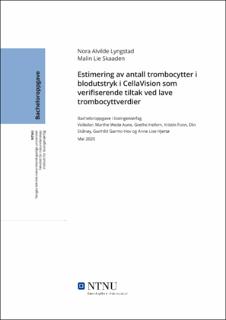| dc.description.abstract | Analysering av trombocytter (PLT) i fullblod er viktig for vurdering av blødningsrisiko, og korrekt prøveresultat er kritisk for å unngå feil medisinsk behandling. I dag benyttes impedansemetoden (PLT-I) som standard for telling av PLT ved avdeling for Medisinsk Biokjemi (AMB), St. Olavs hospital. Metoden er ikke feilfri og utfordringer kan oppstå ved lave PLT-verdier, aggregering og/eller tilstedeværelse av interferenter. Dette påvirker påliteligheten til prøvesvarene som kan bli både falskt for lave og falskt for høye. Mange prøvesvar krever dermed oppfølgende tiltak før de kan rapporteres. Ved AMB benyttes en fluorescensmetode (PLT-F) og en immunologisk metode med monoklonalt antistoff (CD61) som verifiserende tiltak. CD61 anses som fasitmetoden for telling av PLT ved AMB. Dette er dyre analyser, og det er dermed ønskelig å undersøke om en billigere og enklere metode for telling av antall PLT kan tas i bruk.
Målet med prosjektet var å finne ut om estimering av antall PLT i blodutstryk kan benyttes som alternativ til metodene som brukes ved AMB i dag; PLT-F og CD61. Dette er gjennomført ved å sammenligne PLT-verdier målt med metodene PLT-I og PLT-F i Sysmex XN20, CD61 i Celldyn Sapphire, og estimert antall PLT i blodutstryk i CellaVision, spesielt i lavt PLT-nivå. Det var også ønskelig å gjøre en sammenligning av dagens metoder, med CD61 som referansemetode. Prøvene som ble analysert var fullblod tatt av inneliggende pasienter under behandling på St. Olavs hospital, og ble analysert innen 24 timer.
Resultatene viser at uten tilstedeværelse av interferenter vil antall PLT målt med metodene PLT-F og CD61 samsvare godt i lave PLT-nivå, mens antall PLT målt med PLT-I vil gi systematisk høyere PLT-verdier. Ved interferensproblematikk i lavt PLT-nivå kan metodene PLT-I og PLT-F gi falskt for lave eller falskt for høye PLT-verdier i forhold til CD61. Våre funn viser at estimering av antall PLT i blodutstryk samsvarer godt med metodene som benyttes ved AMB i dag; PLT-I, PLT-F og CD61, i PLT-nivå <35x10^9/L. Presisjonen til estimering av antall PLT i blodutstryk, både i lavt og normalt PLT-nivå, viser seg å ligge over kravet på <3,0%.
Konklusjonen er at de eksisterende metodene benyttet ved AMB gir tilnærmet like PLT-verdier ved prøver uten interferenter, men at antall PLT målt med CD61 ser ut til å være den eneste korrekte metoden ved interferensproblematikk. Estimering av antall PLT i blodutstryk har god riktighet i lave PLT-nivå, men presisjonen er ikke innenfor oppgitt krav, og tyder på at metoden ikke er pålitelig nok til å kunne benyttes uten videre undersøkelser. | |
| dc.description.abstract | Thrombocyte (PLT) analysis in whole blood is important for assessing bleeding risk, and correct results are critical to avoid wrong medical treatment. Today, the impedance method (PLT-I) is used as a standard for counting PLT at the Department of Medical Biochemistry (AMB), St. Olav's Hospital. The method is not faultless and challenges can accure at low PLT values, aggregation and/or presence of interferences. This affects the reliability of the test results, which can be falsely too low and falsely too high. Many test results requires follow-up measures before they can be reported. At AMB, a fluorescence method (PLT-F) and an immunological method with monoclonal antibody (CD61) are used as verification measures. CD61 is the method considered to be most correctly at AMB for counting PLT. These analyzes are expensive, and it is thus desirable to look into a cheaper and easier method for counting PLT.
The main purpose of this project was to find out if estimating the number of PLTs in blood smears can be used as an alternative to the methods used by AMB today; PLT-F and CD61. This was achieved by comparing PLT values with the PLT-I and PLT-F methods in Sysmex XN20, CD61 in Celldyn Sapphire, and estimating the number of PLTs in blood smears in CellaVision, especially at low PLT levels. It was also desirable to compare today’s methods, with CD61 as a reference method. The samples analyzed was whole blood from patients under treatment at St. Olav's Hospital and were analyzed within 24 hours.
The results show that without presence of interferences the number of PLTs counted with the PLT-F and CD61 methods are corresponding well at low PLT levels, but the PLT-I will provide systematic higher PLT-values. Interference problems at low PLT levels, can give falsely too low or falsely too high PLT values counted with PLT-I and PLT-F methods, relative to the CD61 method. By comparison, our findings show that estimation of the number of PLTs in blood smears correspond well with the methods used by AMB today; PLT-I, PLT-F and CD61, at PLT levels <35x10^9/L. The precision for estimating the number of PLTs in blood smears, both at low and normal PLT levels, are found to exceed the requirement of <3,0%.
The conclusion is that without interferences, the methods used at AMB will provide approximately the same PLT values, but CD61 appear to be the only correct method for samples with interference problems. Estimating the number of PLTs in blood smears has good accuracy at low PLT levels, however the precision does not meet the requirement, suggesting the method is not reliable enough and should be examined more closely. | |
